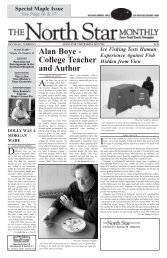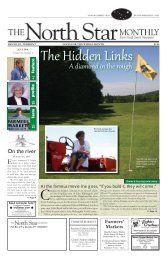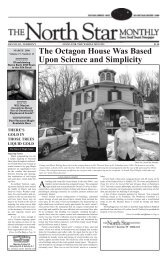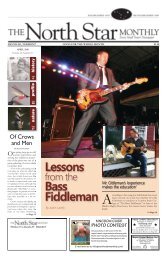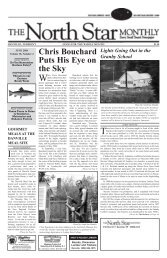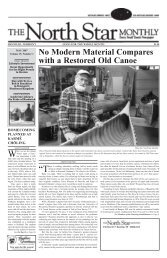May - The North Star Monthly
May - The North Star Monthly
May - The North Star Monthly
You also want an ePaper? Increase the reach of your titles
YUMPU automatically turns print PDFs into web optimized ePapers that Google loves.
4 MAY 2010 THE NORTH STAR MONTHLY<br />
A thirst for green<br />
BY ISOBEL P. SWARTZ<br />
No, I don’t mean green beer, money, environmental innovation or any other<br />
material forms of green of that type! I mean that unquenchable thirst for the<br />
green of springtime after a drab, gray winter.<br />
Burrington’s Greenhouse<br />
Route 15, West Danville, VT<br />
(802) 684-2229<br />
OPENING FOR THE SEASON<br />
Thursday, <strong>May</strong> 6<br />
Geraniums Hanging Plants Bedding Plants<br />
Vegetable Plants Perennials Cemetery Pots<br />
Open 9 a.m. - 7 p.m. Daily<br />
See you this summer at the Caledonia Farmers’ Market!<br />
Saturdays in St. Johnsbury, Wednesdays on the Green in Danville<br />
When you think insurance...<br />
663 Old Center Road, St. Johnsbury, Vermont 05819<br />
(802) 748-8797 Fax (802) 748-8609<br />
Instructor:<br />
Damien Ar-<br />
YOGAchambeau<br />
For Scoliosis<br />
and<br />
Back<br />
Care<br />
BARNET TRADEPOST<br />
WELLNESS CENTER<br />
MONDAYS<br />
5:30 - 7 PM<br />
for more info or to sign up<br />
802.633.2700 ext.1<br />
or email:<br />
lj@barnettradepost.com<br />
I wonder whether this passion is just a <strong>North</strong>ern<br />
phenomenon, or whether perhaps it also belongs<br />
to desert dwellers, but as soon as there is any<br />
bare earth exposed after the winter, my eyes are<br />
vigilant, searching for the first blades of new grass.<br />
When my husband and I used to take groups<br />
of Academy students on trips to foreign places<br />
during the spring vacation the delighted remarks<br />
came thick and fast after the plane landed in England,<br />
France, Italy or Spain, “Oh look how green it<br />
is!” No matter that the weather might be only marginally<br />
warmer than Vermont, it was the color that<br />
mattered. <strong>The</strong> same thing would happen on our<br />
infrequent trips south in March. By south I mean<br />
to Poughkeepsie, New York, where we had family<br />
in the balmy Hudson River Valley! On day trips<br />
from there to the City we would remark on greening<br />
grass, the yellow glow of the willow twigs and<br />
the almost imperceptible, except to us, swelling of<br />
buds on the trees.<br />
All this goes to show that you see what you<br />
want to see, but when it comes to spring in the<br />
north-country nowhere does “green” better, except<br />
perhaps the Yorkshire Dales. After the early<br />
struggles of the new blades of grass to overcome<br />
the dingy brown of the old, there is that glorious<br />
time when the earth is an iridescent blue-green,<br />
never to be seen again until next year. Is that color<br />
a trick of the light, or is this green, in fact, different<br />
from that which follows? All I know is that it<br />
is food for the human soul.<br />
Spring flowers soon distract us from the total<br />
pleasure of green. <strong>May</strong>be this is why the intensity<br />
of the green itself seems to change, taking on a<br />
slightly yellowish hue. Meanwhile trees get into the<br />
act, sprouting forth in an array of greens and notso-<br />
greens as the new leaves throw off their scales<br />
of gold, red and brown.<br />
My mother always said that green is restful to<br />
the eye. And in fact studies do show that an environment<br />
containing a lot of green can reduce<br />
tiredness. This is supposedly why the interiors of<br />
British hospitals and schools used to be painted<br />
abundantly in green. This was not the green about<br />
which I feel so excited, but a nasty shade of pea<br />
soup green.<br />
This was also frequently the shade of green of<br />
a dessert called blancmange that I loathed as a<br />
child. It was a kind of milky, starchy gelatin tasting<br />
of very little, with a nasty texture and a disgusting<br />
thick skin on the top (later the base after<br />
un-molding). Its only redeeming feature as far as<br />
I could see was that it could be molded into fantastic<br />
shapes that no mere Jello could ever assume<br />
and firmly hold. It was a feature of many a birthday<br />
party that I attended as a small child. As I was<br />
a picky eater but a shy child, I was always afraid to<br />
say I didn’t want any, and so I suffered the torture<br />
of what was supposed to be a fun-filled party meal.<br />
After one battle with blancmange where the blancmange<br />
won and I was very sick, the hostess made<br />
such a fuss that I made some impolite remark that<br />
led me to have my mouth washed out with soap<br />
when I got home. I have never since seen that<br />
shade of green without tasting soap in my mouth!<br />
Two time-worn idioms come to mind regarding<br />
the joys of spring green. “Absence makes the<br />
heart grow fonder” is exemplified by that great delight<br />
in seeing the first blades of grass and the glow<br />
of the earliest dandelions near a warm stone wall.<br />
<strong>The</strong>n we all, like jaded lovers, move on to “familiarity<br />
breeds contempt”, as we tune up the lawnmower,<br />
pull up weeds in the garden plot and try<br />
vainly to eradicate the dandelions in the lawn. No<br />
matter how hard Nature tries to please us, we humans<br />
are never content! Despite my own fickleness<br />
I hope that I shall always have a springtime<br />
thirst for green. And have it satisfied!<br />
A glimpse of the stage<br />
BY BETS PARKER ALBRIGHT<br />
When I was about nine years old, my<br />
mother decided that I would benefit<br />
from joining a small dramatics class being<br />
held for children from five to thirteen years<br />
of age. She had met the two English women<br />
who had organized the group when they<br />
came to an art show she assembled to display<br />
her paintings. She told them I was interested<br />
in acting, and they said they were<br />
happy to have me join their class.<br />
This was the start of an exciting time for me. I<br />
looked forward to the two afternoons a week when<br />
I would attend the King-Coit School. It was held in<br />
a delightful Victorian house full of tricky old staircases<br />
and intriguing rooms in which stage sets<br />
could be set up and rearranged as needed.<br />
<strong>The</strong> two women had an interesting approach to<br />
teaching. <strong>The</strong>y would tell us stories and then allow<br />
us to decide how to bring them to life. We used our<br />
own words at first, then our teachers would suggest<br />
what they felt were more appropriate ones.<br />
Later, when we acquired more experience, we were<br />
read scenes from Shakespeare or from traditional<br />
fairy tales. We were encouraged to use our imagination,<br />
and to use words we encountered in stories<br />
in place of everyday words. We were taught to<br />
speak well, as though we were addressing an audience<br />
from the stage.<br />
I was an enthusiastic reader of stories, especially<br />
fairy stories. I worked my way through the<br />
Blue Fairy Book, the Red Fairy Book, etc., many<br />
Grimm’s fairy tales, and others. It was fun to re-do<br />
stories to my liking, avoiding “once upon a time”<br />
and “they lived happily ever after,” etc. It was fun<br />
to combine book stories with our own inventions.<br />
When a good plot worked out, we all got together<br />
to create a real play. This gave us a chance to act,<br />
create sets, and sometimes to sing and dance.<br />
As our unusual little school grew and attracted<br />
more children, our performances became of interest<br />
to people who liked to see children perform. A<br />
young man who specialized in doing stage sets became<br />
intrigued with what we were doing. He began<br />
to design sets that could be taken down and set up<br />
in regular theaters. This led to exciting adventures<br />
for us!<br />
I easily developed crushes on my favorite actors,<br />
who included Leslie Howard and Katharine<br />
Hepburn. I bore some physical resemblance to<br />
Hepburn, and I learned to imitate her manner of<br />
speaking. <strong>The</strong> resemblance faded with the years,<br />
but it was great fun while it lasted!<br />
My most challenging dramatic experience was<br />
when I was chosen to play the magician Prospero<br />
in “<strong>The</strong> Tempest.” At that time I was one of the<br />
older students and big enough to manage the role.<br />
I was thrilled at the chance, and I’m sure I drove my<br />
family crazy rehearsing Prospero’s stirring words,<br />
such as “I’ll break my staff, bury it certain fathoms<br />
in the earth” and “Deeper than did ever plummet<br />
sound, I’ll drown my book!”<br />
In time, of course, I outgrew the special school.<br />
This was sad for me, but the experience had taught<br />
me useful things, and instilled in me a lifelong love<br />
and attraction for the dramatic arts. It gave me the<br />
opportunity and confidence later on to act in plays<br />
with several of my children who were similarly inclined.<br />
That was deeply satisfying, even though I<br />
never achieved my desire to become a “real” actress<br />
and follow in the tracks of my girlhood idol<br />
Katharine Hepburn!



